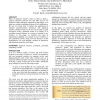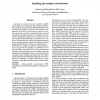HT
2000
ACM
14 years 4 months ago
2000
ACM
Clustering separates unrelated documents and groups related documents, and is useful for discrimination, disambiguation, summarization, organization, and navigation of unstructure...
HT
2000
ACM
14 years 4 months ago
2000
ACM
Much of hypertext narrative relies on links to shape a reader’s interaction with the text. But links may be too limited to express ambiguity, imprecision, and entropy, or to adm...
HT
2000
ACM
14 years 4 months ago
2000
ACM
This paper proposes the inclusion of travel and mobility in the usability metrics of web design. Hypertext design and usability has traditionally concentrated upon navigation and/...
HT
2000
ACM
14 years 4 months ago
2000
ACM
XLink is an emerging Internet standard designed to support the linking of XML documents. We present preliminary work on using XLink as an export format for the links of an open hy...
HT
2000
ACM
14 years 4 months ago
2000
ACM
A CoWeb is a collaborative Web space that allows people to modify content and create new pages in a very easy fashion. We modified the original CoWeb to visualize interaction hist...
HT
2000
ACM
14 years 4 months ago
2000
ACM
This paper presents the principles of ontology-supported and ontology-driven conceptual navigation. Conceptual navigation realizes the independence between resources and links to ...
HT
2000
ACM
14 years 4 months ago
2000
ACM
In August of 1998 I completed the first hypertextual dissertation at Rensselaer Polytechnic Institute. The dissertation was a case study applying methods of rhetorical analysis an...
HT
2000
ACM
14 years 4 months ago
2000
ACM
The qualities of non-sequentiality that make hypertext so appealing to writers and readers of informative and literary texts are also those that problematize arguments in the same...
HT
2000
ACM
14 years 4 months ago
2000
ACM
We describe a way to make a hypermedia meeting record from multimedia meeting documents by automatically generating links through image matching. In particular, we look at video r...
WISE
2000
Springer
14 years 4 months ago
2000
Springer
Searching the internet using the currently available searchengines is not satisfactory. Thetechniquesused there focus on the extraction of relevant informationdirectlyfrom the doc...


